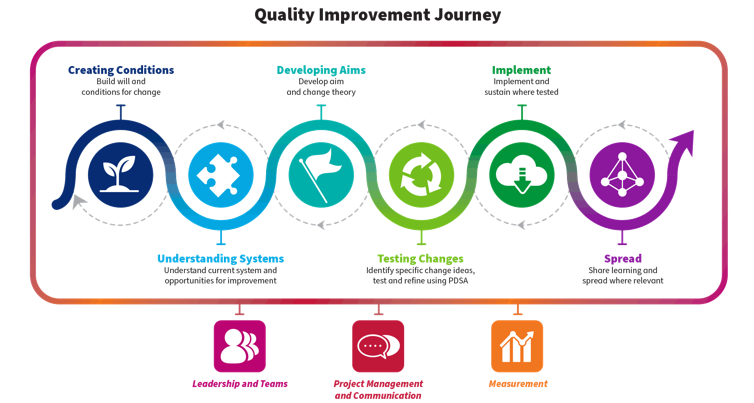Quality Improvement
Quality Improvement
Quality Improvement is a method for improving things in health and social care. It is a systematic approach. Tools enable system understanding and testing and measurement of improvement ideas.
The image below shows the quality improvement journey of an improvement project. It is not linear. It is an iterative process. At each stage you should involve people. This includes staff, and those with lived experience.
Below you will find tools for each stage of the improvement journey.
Access other relevant tools and information on the Quality Improvement Zone.

Creating conditions
To create the conditions for change you should involve staff and others early.
Involve your improvement team in creating your Project Charter.
This should include:
- the reason you are doing this work (what is it and why does it matter?)
- a short summary of your aim,
- the scope of the project,
- ideas for change,
- how you will measure the improvement,
- who you will involve and
- any risks to the project.
Resources:
Understanding systems
If you want to get different outcomes you need to understand what is currently happening. You can use this knowledge to identify changes to test.
You can use tools and methods to help you understand your system. You should include your improvement team in the use of these tools. Involve any relevant others too.
Resources:
Developing aims
Develop your aims and measures when you know what improvements you want to make. The measures should let you know if you meet your aim.
A logic model will help you to focus on your aims, activities and planned outcomes.
You can create your measurement plan from your logic model. This plan will outline how you will measure your outcomes.
A driver diagram presents a team's theory of how to achieve an improvement goal. This will help to identify and define your change ideas.
Involve your improvement team in the use of the tools below.
Resources:
Example driver diagram MHSU: IoR Inverclyde Discharge Planning
Testing changes
Testing the changes you want to make requires planned review and reflection. Study the data before and after testing changes. This will help you determine if the change has made any impact. You can then amend any aspects before implementing.
A Plan Do Study Act (PDSA) cycle is helpful for considering what you want to find out from a test of change. You should make predictions about what will happen and reflect on learning from the test. Involve your improvement team in this.
A Run Chart is a helpful way of displaying data. It lets you analyse the effectiveness of introducing your test of change.
Implement
Implementation planning templates can support your team. You should consider:
- the impact of change ideas,
- enablers and barriers to change,
- roles and responsibilities, and
- immediate next steps.
Implementation planning guidance
Spread
Check if the improvements have sustained, after you have tested and implemented your change idea. If so, it may be time to spread to new areas, teams or other parts of your system.
Successful spread involves developing a spread plan and a spread aim. This will help you measure and review progress. Using the “Readiness for Spread” checklist can help you to assess if your change idea is ready to spread.
As an improvement team, ask yourselves five questions to spread improvement.
